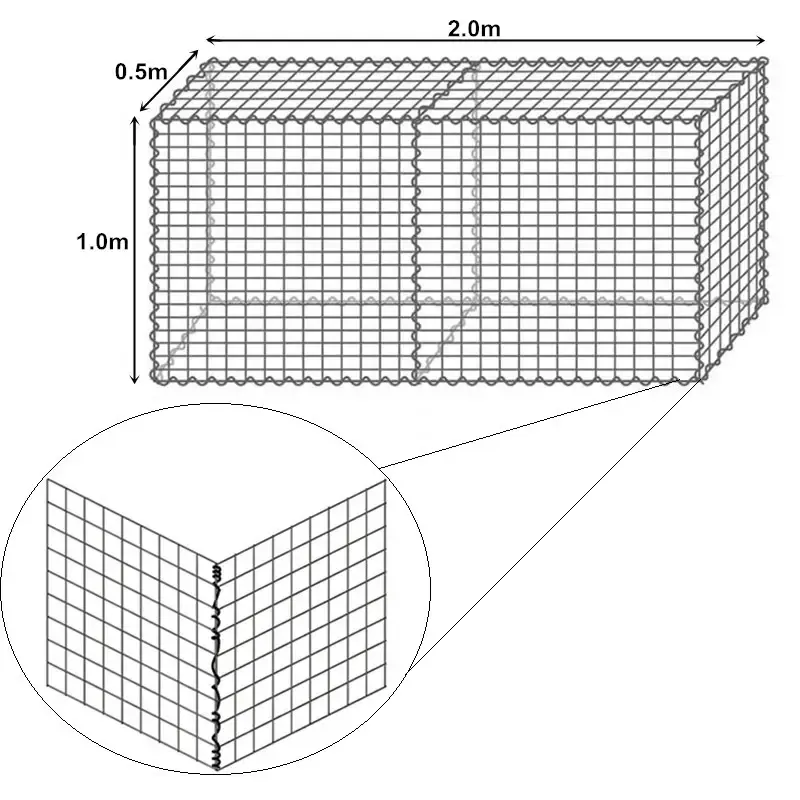
- Afrikaans
- Albanian
- Arabic
- Armenian
- Azerbaijani
- Basque
- Belarusian
- Bengali
- Bosnian
- Bulgarian
- Croatian
- Czech
- Danish
- Dutch
- English
- Esperanto
- Estonian
- Finnish
- French
- Galician
- Georgian
- German
- Greek
- hawaiian
- Hindi
- Hungarian
- Indonesian
- irish
- Italian
- Lao
- Latvian
- Lithuanian
- Luxembourgish
- Macedonian
- Maltese
- Myanmar
- Norwegian
- Polish
- Portuguese
- Romanian
- Russian
- Serbian
- Slovak
- Somali
- Spanish
- Swedish
- Thai
- Turkish
- Turkmen
- Vietnamese
Okt . 07, 2024 11:46 Back to list
gabion blocks
The Versatility and Benefits of Gabion Blocks
Gabion blocks, often referred to simply as gabions, are increasingly gaining popularity in various civil engineering and landscaping projects. These wire mesh containers filled with materials such as rocks, stones, or concrete are known for their versatility, strength, and aesthetic appeal. Originally used for hydraulic engineering and erosion control, gabions have found their place in a wide array of applications ranging from retaining walls to decorative garden features.
One of the primary advantages of gabion blocks is their structural integrity. When filled with heavy materials, they are exceptionally stable and can effectively withstand significant forces. This characteristic makes them ideal for erosion control along riverbanks, roadsides, and other structures susceptible to water exposure. Unlike traditional retaining walls that require extensive footings and concrete, gabions rely on gravity to maintain their position, making them a more eco-friendly and cost-effective solution for managing earth and water flow.
In addition to their engineering benefits, gabions offer aesthetic versatility. They can be designed to blend seamlessly into their surroundings or to stand out as architectural features. Landscape architects and designers often use gabion walls in gardens, parks, and public spaces. The natural stone filling can complement various landscaping styles and provide a rustic charm that is increasingly sought after in modern designs. Moreover, gabions can serve as planters, where soil can be introduced into the mesh structure, allowing for the growth of plants and adding vibrancy to outdoor environments.
Erosion prevention is another significant benefit of gabion blocks
. In areas prone to soil degradation, these structures can act as barriers that slow down water runoff, allowing sediment to settle. This natural filtration process not only protects the soil but also promotes healthier ecosystems in surrounding areas. They can be strategically placed on slopes or along beaches to minimize the impact of wave action and reduce the risk of land erosion.gabion blocks

Installation of gabion blocks is relatively straightforward compared to traditional construction methods. The modular nature of gabion systems means that they can be easily customized to suit specific site conditions. Gabions are typically assembled on-site, where the wire mesh cages are filled with rocks or other materials provided by the user. This makes them an excellent option for remote locations or projects with limited accessibility. Additionally, because the materials used in filling can often be sourced locally, this reduces transportation costs and aligns with sustainable building practices.
However, it is essential to be mindful of the potential downsides. Gabion structures should be designed properly to account for load distributions and placement. If not installed correctly, they may slide or settle unevenly over time. Proper drainage systems should also be in place to avoid water accumulating behind the walls, which could lead to increased pressure and potential failure of the gabion structure.
Ultimately, the use of gabion blocks represents a marriage of functionality and aesthetics, making them a unique solution for various engineering and landscaping challenges. Their ability to adapt to multiple scenarios—from stabilizing slopes to enhancing garden design—coupled with sustainable construction practices, positions gabions as a favorable choice for modern construction projects.
In conclusion, whether for practical applications such as erosion control or for beautifying outdoor spaces, gabion blocks are a remarkable option that embodies strength and style. As we continue to seek sustainable and cost-effective building solutions, it is likely that gabion technology will expand further into urban landscapes and natural settings alike, offering innovative ways to solve contemporary engineering problems.
-
Your Ultimate Solution for Australian Temporary Fencing
NewsMay.14,2025
-
The Ultimate Guide to Crowd Control Barriers: Secure Your Events with Ease
NewsMay.14,2025
-
Secure Your Livestock with High-Quality Livestock Fence Panels
NewsMay.14,2025
-
Enhance Your Livestock Management with Top-Quality Cattle Fences
NewsMay.14,2025
-
Enhance Security and Safety with Temporary Fencing Solutions
NewsMay.14,2025
-
Corral Gates
NewsMay.14,2025









